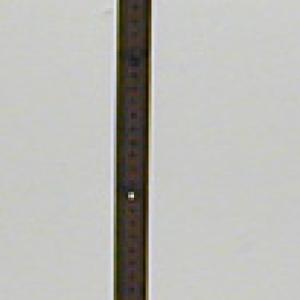College of Liberal Arts & Sciences
3A15.20 - Physical Pendula
The rigid Pendula are used to show the characteristic differences of a pendulum that has the weight distributed through the length of the pendulum.
A simple pendulum with a length 2/3's of a physical pendulum will have the same period. In our case a 66 cm long simple pendulum has the same period as our 1 m physical pendulum.
Theoretically, the physical pendulum will have the same period when swung from the end of the pendulum or from a point approximately 29 cm from the end. In our case since the pivot point on the end is inward 1/2 cm, the other equal period point is at 32 cm from the end.
- Jesus Palacios Gomez, Roque Andre Eleazar Arroyo Villagomez, "The Physical Pendulum: An Illustrative Teaching Laboratory Example Using a Long Rod", TPT, Vol. 61, #1, Jan. 2023, p. 76.
- Milentije Lukovic, Vanja Lukovic, Milos Bozic, Vojislav Vujicic, "Inexpensive Physical Pendulum with Arduino", TPT, Vol. 59, #6, Sept. 2021, p. 432.
- Efstratios Kapotis and Chrysoleon Symeonides, "Learning from a Museum Exhibit: The Case of the 19th-Century Compensation 'Gridiron' Pendulum", TPT, Vol. 57, #4, Apr. 2019, p. 222.
- Yaakov Kraftmakher, "Driven Pendulum: An Advanced Experiment", TPT, Vol. 56, #9, Dec. 2018, p. 636.
- Yaakov Kraftmakher, "Computerized Physical Pendulum for Classroom Demonstrations", TPT, Vol. 43, #4, Apr. 2005, p. 244.
- Paul Gluck, "Versatile Physical Pendulum", TPT, Vol. 42, #4, Apr. 2004, p. 226.
- Francis X. Hart, "Solvering" the Physical Pendulum", TPT, Vol. 42, #3, Mar. 2004, p. 150.
- Bruce Denardo, "Demonstration of the Parallel-Axis Theorum", TPT, Vol. 36, #1, Jan. 1998, p. 56.
- John Sherfinski, "A Counterintuitive Physical Pendulum Lab", TPT, Vol. 35, #4, Apr. 1997, p. 252.
- R.W. Robinett and P.E. Sokol, "Investigating Physical Pendula with K'Nex", TPT, Vol. 34, #7, Oct. 1996, p. 427.
- C. Gregory Hood, "Note on a Physical Pendulum Experiment", TPT, Vol. 34, #6, Sept. 1996, p. 327.
- Charles J. Reidl, Jr., "Moment of Inertia of a Physical Pendulum", TPT, Vol. 34, #2, Feb. 1996, p. 114.
- John E. Carlson, "The Pendulum Clock", TPT, Vol. 29, #1, Jan. 1991, p. 8.
- Bruce Denardo and Richard Masada, "A Not-So-Obvious Pendulum Experiment", TPT, Vol. 28, #1, Jan. 1990, p. 51.
- John F. Goehl, Jr., "No Calculus Needed", TPT, Vol. 27, #7, Oct. 1989, p. 502.
- Rick Guglielmino and Tom Boyce, "The Search for a Harmonic Minimum", TPT, Vol. 27, #5, May 1989, p. 361.
- Mario Iona, "The Physical Pendulum", TPT, Vol. 17, #4, Apr. 1979, p. 224.
- Julius Sumner Miller, "Another Enchanting Thought", TPT, Vol. 17, #3, Mar. 1979, p. 152.
- George Oleh Kolodiy, "An Experiment with a Physical Pendulum", TPT, Vol. 17, #1, Jan. 1979, p. 52.
- L. C. Corrado, "The Meter Stick Pendulum", TPT, Vol. 12, #8, Nov. 1974, p. 494.
- George W. Horton, "Some Laboratory Work With Physical Pendulums", TPT, Vol. 4, #2, Feb. 1966, p. 78.
- H. Hauptfleisch, T. Gasenzer, K. Meier, O. Nachtmann, and J. Schemmel, "A Computer Controlled Pendulum With Position Readout", AJP, Vol. 78, #6, June 2010, p. 555.
- John C. Simbach and Joseph Priest, "Another Look at a Damped Physical Pendulum", AJP, Vol. 73, #11, Nov. 2005, p. 1079.
- Thomas B. Greenslade, Jr. and Aaron J. Owens, "Reconstructed Nineteenth-Century Experiment with Physical Pendula", AJP, Vol. 48, #6, June 1980, p. 487.
- M-904: "Pendula - Torsion & Physical", DICK and RAE Demo Notebook.
- Julius Sumner Miller, "Forces and Masses", Physics Fun and Demonstrations, p. 98.
- Yaakov Kraftmakher, "2.2, Pendulum", Experiments and Demonstrations in Physics, ISBN 981-256-602-3, p. 84.
- Robert L. Wild, "Several Pendulums", Low-Cost Physics Demonstrations, #42, p. 28.
- George W. Horton, "Some Laboratory Work with Physical Pendulums," Apparatus for Teaching Physics.
- Robert Ehrlich, "8.3 - Period of a Physical Pendulum", Why Toast Lands Jelly-Side Down, p. 123 - 124.
Disclaimer: These demonstrations are provided only for illustrative use by persons affiliated with The University of Iowa and only under the direction of a trained instructor or physicist. The University of Iowa is not responsible for demonstrations performed by those using their own equipment or who choose to use this reference material for their own purpose. The demonstrations included here are within the public domain and can be found in materials contained in libraries, bookstores, and through electronic sources. Performing all or any portion of any of these demonstrations, with or without revisions not depicted here entails inherent risks. These risks include, without limitation, bodily injury (and possibly death), including risks to health that may be temporary or permanent and that may exacerbate a pre-existing medical condition; and property loss or damage. Anyone performing any part of these demonstrations, even with revisions, knowingly and voluntarily assumes all risks associated with them.
